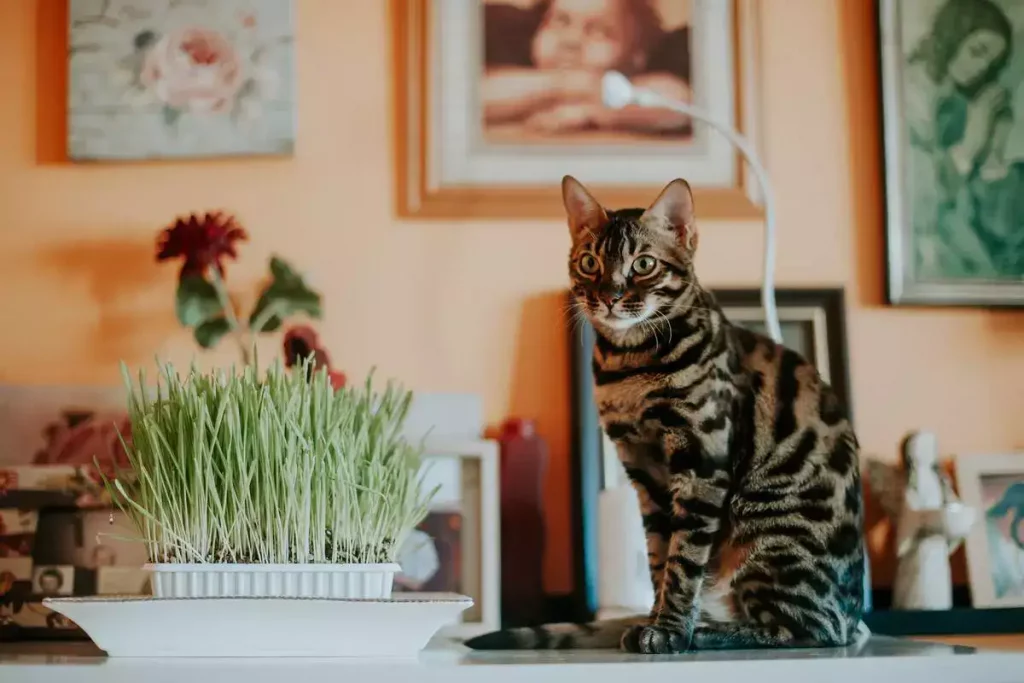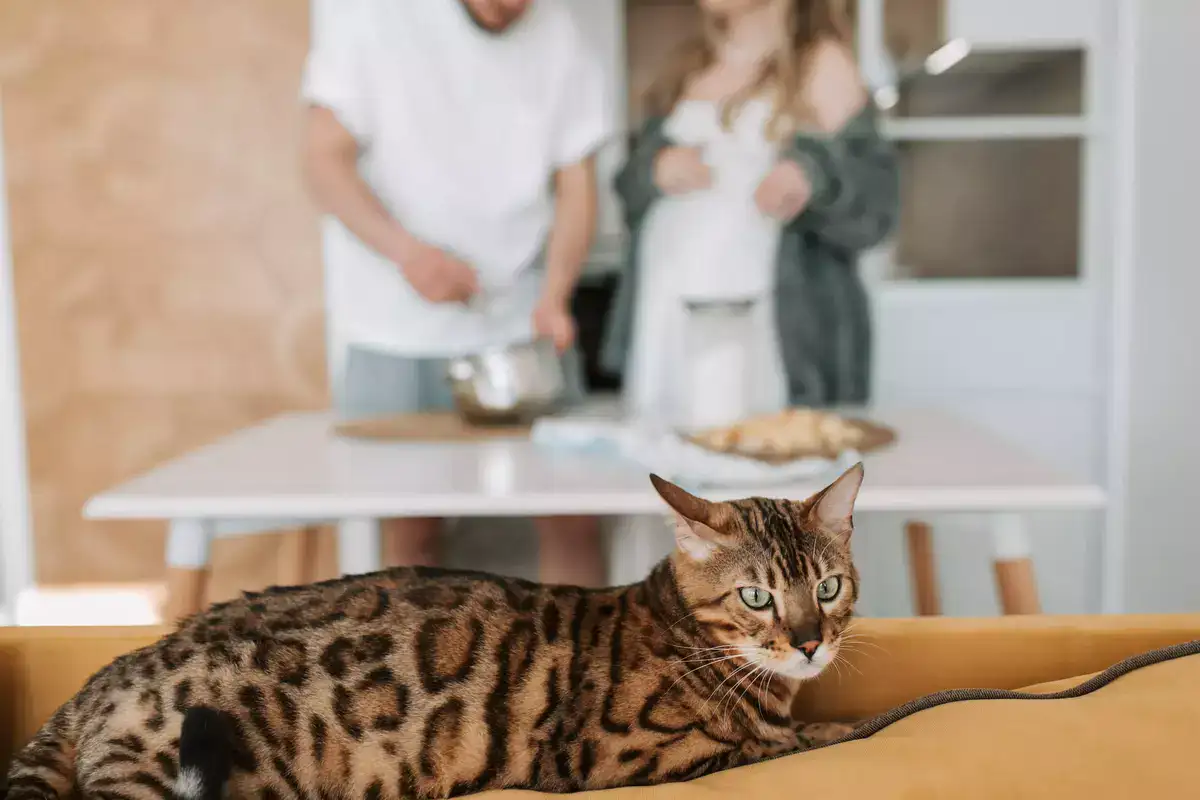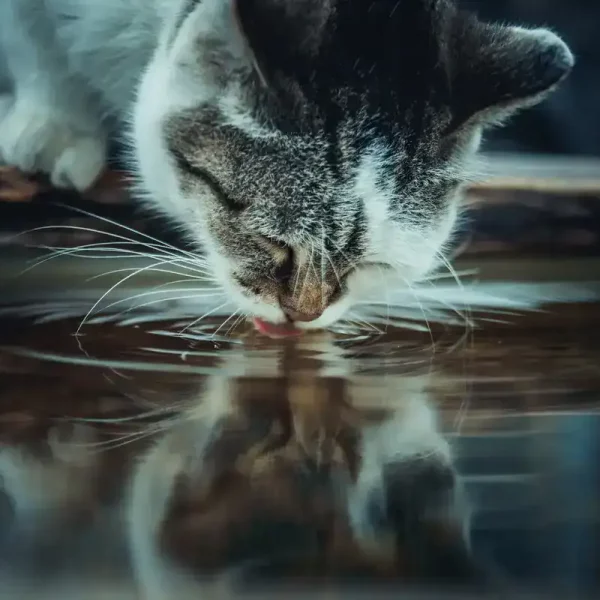Knowing whether your Bengal cat is pregnant or not isn’t always easy, particular during the early stages of pregnancy. However, there are some tips that breeders use to help them tell if a Bengal cat is pregnant or not; and I will share those with you today.
If you read on you will find out what the early gestation signs are, what the Bengal cat pregnancy stages are, and how you can make her as comfortable as possible.
The early signs of a Bengal cat pregnancy
- Your Bengal cat’s appetite will decrease, and she might even miss some meals altogether.
- Your Bengal cat’s stomach could get bigger, sometimes as soon as 14 days after insemination.
- Your vet could feel her belly, possibly feeling movements as soon as 20 to 30 days.
- Your Bengal may exhibit behavioral changes including lethargy.
- Your Bengal’s nipples might have become enlarged in readiness for nursing.
None of the methods above are fool-proof checks to tell whether your Bengal cat is pregnant and expecting a litter of kittens though. Instead vets and breeders rely on more scientific methods to test for pregnancy, including Bengal cat ultrasounds, all of which you can see below.
How to tell if a Bengal is pregnant
To check for certain if your Bengal is pregnant, there are two methods which will offer 100% proof of pregnancy.
1. Bengal ultrasound 25 days after mating
The fastest method for finding if your Bengal has conceived is to get your vet to perform a Bengal ultrasound. This scan can be first done 3 weeks after mating, but at this early stage it won’t always be 100% accurate – the best results come with an ultrasound at least 25 days after conception.
Ultrasounds are pain-free, but it can be a stressful occasion if your Bengal doesn’t like the vets as their belly hair will be shaved off.

The costs of an ultrasound pregnancy check tend to range between the $300 to $500-dollar bracket (£230 to £380 GBP). It’s not a cheap method, and many people will simply wait until their Bengal is showing more obvious signs of pregnancy rather than paying for a scan.
2. Blood sample at 5 weeks after mating
The second option for a pregnancy test is using a blood test. This can be performed after 5 weeks post mating and will help to detect a pregnancy hormone in your Bengal.
It doesn’t cost as much as an ultrasound but isn’t always accurate when done too early on. For example, if your Bengal has been pregnant for less than 35 days, it might flag up as being negative, even if she is pregnant.
What is the most reliable Bengal pregnancy test then?
The most accurate way to know if your Bengal is pregnant is the first option; the Bengal ultrasound. However, it should only be done after 25 days post mating, otherwise it might throw up an inaccurate result.
One the best things about this type of pregnancy test is how you can see the developing kittens on the scan images. You might also be able to tell at this point how many kittens your Bengal is expecting, although it might not always be an exact count due to their size and overlapping in the womb.
If you wait another 20 days, but day 45 you can also get an X-ray of the pregnant Bengal. This will let the vet count the skulls in the womb, giving a 100% accuracy count on how many kittens are in the litter.
Ever heard about the Bengal Abyssinian Mix? Learn more in my guide here.
Bengal pregnancy stages
Once you know your Bengal is pregnant, the excitement can really start. But what can you expect from the Bengal pregnancy stages? Here’s a quick overview of each stage.
Month 1
The first month of your Bengal’s pregnancy isn’t actually that interesting, and a lot of the time you might not even notice anything at all. Some owners won’t even know their Bengal is pregnant without the aid of an ultrasound.
By day 7 of the pregnancy, Bengal kittens embryos will get to the uterine horns. By 14 to 16 days the Bengal embryos will have attached themselves into the lining of the mother’s uterus.
The 22nd day will typically see the Bengal fetuses starting to form, and around the 29th day, vets are able to detect heart beats using an ultrasound scan.
Your Bengal will now 3 weeks pregnant and should start showing some of the pregnancy signs I spoke of earlier. At this point those signs may even change a little to be:
- Your Bengal might now be eating more than usual after the loss of appetite earlier in the pregnancy.
- Your Bengal’s nipples should now be larger than they were before.
- Your Bengal might change behavior, looking for comfort and cuddles with her owner.
- Your Bengal might have a clear discharge during the 4th
- Your Bengal will start to slow down and reduce her activity levels.
- Your Bengal could even start showing signs of feline morning sickness.
Whilst these are typical signs of Bengal pregnancy, not all Bengals will exhibit these. It’s still very early on in the pregnancy and can be hard to detect properly.
Handy Hint: Bengals can actually have false pregnancies. I wrote a guide which includes information on what to look for and how long a cat’s phantom pregnancy can last.
Month 2
The second month is where the pregnancy signs start to accelerate with the eyelids and toes appearing on the fetuses between the 32nd and 35th day.
The development is very rapid, as by day 40, the Bengal fetuses will have grown claws, and by day 45 have a skeletal form and even a coat.
You could ask your vet to perform an X-ray on the 50th day as it will be possible to use this to check how many kittens your Bengal is expecting. It’s very exciting, as you can now plan for the litter size!
By the 58th day, your Bengal will start her nesting behavior. This is where she starts looking for a safe and comfortable place in the house to give birth. Owners can help their cats with added bedding and creating a more secure environment for them.

It should now be outwardly obvious that your Bengal is pregnant, as she will certainly now be showing a rounder belly.
More signs of Bengal pregnancy at this stage include:
- Your Bengal will be eating a lot more than usual.
- Your Bengal will then start to eat less again around the 45th
- Your Bengal will gain significant weight
- Your Bengal will need to urinate more than usual.
- Your Bengal will have a clear vaginal discharge.
- Your Bengal’s belly will become firmer between the 45th and 50th
- Your Bengal’s belly might show signs of movement by day 50.
Month 3
The third month is when you can ratchet up the excitement. You will definitely now know that your Bengal is pregnant, as there’s no mistaking it in this stage.
Yep, you guessed it, during this Bengal pregnancy stage she will be giving birth. The kittens will start to move into position to arrive as by the 58th day they are almost completely formed – they will move into the birth canal for the last few days of pregnancy.
The signs during this stage you will start to see include:
- Her waist will get slimmer as the kittens move into position.
- She will not want to eat much around days 61 and 62.
- Her temperature will drop around 1 and 2 days before birth.
- She will start to get agitated and restless.
- She could even increase the nesting actions such as digging, pacing, panting, and shivers.
Bengal pregnancy tips
Your Bengal will be pregnant for between 58 and 68 days. The average length of a Bengal pregnancy is about 63 days from the mating date to delivery.
There will be plenty of behavioral changes in your Bengal too, not just physical ones. For example, as she enters the last 14 days of pregnancy you might see the following signs:
- Your Bengal will want to cuddle you more.
- Your Bengal won’t want to socialize with other cats.
- Your Bengal will be calmer and less excitable.
- Your Bengal might appear to be uncomfortable.
- Your Bengal might want to sleep more and even in different places.
How to prepare for a Bengal pregnancy
As a breeder or owner, there are things you can also do to make sure your Bengal is ready to have a comfortable pregnancy and then give birth safely. These preparation tips include:
- Change her diet after month 1 by adding kitten kibble. This is smaller and more nutritious for growing kittens.
- Don’t over-exert her and she will be more tired and have a lot less energy. Her breathing might also become strained.
- Help her with the nesting process, making up her crate as comfortable as possible and not at the last minute. She needs to feel safe and secure, and know that she has a place to give birth safely and securely.
How Bengal give birth
The most common way that a Bengal will give birth is by a c-section. It’s rare for them to give birth naturally, but here’s an overview of both aspects.
1. C-section
This technique is the most common for Bengals. It’s because Bengal skulls can be large compared to how wide the mother’s birth canal is – and that will lead to obvious complications and risks.
Your vet can help you to decide if this is the best option by using an X-ray to check how large the skulls are, and how many kittens are expected.
Bengal c-sections can cost between $640 and $1,300 dollars (£500 and £1,000 GBP). There are some risks to this surgery as it will be performed under an anesthetic.
2. Natural birth
If you decide to let things happen naturally after consultation with your vet, look out for the warning signs that your Bengal is ready to give birth to her litter.
If it’s time for your Bengal to give birth, then make sure her nest is completely ready. You will notice that she will start to visit her nest several times, returning back and forth to the area, scraping the towels several times, and then finally settling down and panting like she’s just had a lot of exercise.
This is not a calm time for her at all, and you will notice heavy breathing and an increased heart rate. It can take up to 12 hours for the first of the kittens to appear.
After a kitten has been delivered, the Bengal mother will bite at the sack and lick the excess away from the kitten. This lets the newborn start to breath in oxygen. Some owners might have to help with this if the mother struggles to do so.
You might even see the Bengal mother eating the sack and umbilical cords. Don’t be alarmed, as they actually contain nutritional elements and it’s entirely instinctive.
Once the Bengal kitten is out and moving, you can help my placing it onto the mother’s nipples to let them start feeding.
When to worry
Whilst most births should go without a hitch (if recommended by a vet), there are warning signs that the delivery isn’t going to plan.
For example, if 10 hours have passed since she nested and sat down and you still haven’t seen a kitten, it could mean a blockage in the birth canal. This will then require an emergency c-section.
Handy Hint: If you do opt for a natural birth and encounter complications you will have to pay for an emergency c-section which will be far more expensive than if you had just booked one in to start with.
Conclusion
Knowing when your Bengal is pregnant is absolutely essential. If you don’t know she’s expecting, you can’t prepare her for the birth, and could put her and the litter at risk of miscarriage.
When it comes to the birth itself, most breeders I have spoken recommend c-sections versus natural births, as the delivery tends to be a lot safer.
If you do have a pregnant Bengal, then I wish you and her all the best and would love to see some photos of the kittens!



Leave a Comment